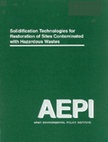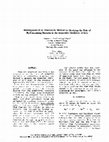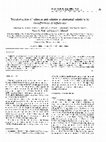Papers by Francisco A Tomei Torres
El autor declara que no existe ningún conflicto de interés. (*) Esta publicación fue escrita por ... more El autor declara que no existe ningún conflicto de interés. (*) Esta publicación fue escrita por Francisco Alberto Tomei Torres, Ph. D., en su capacidad personal. Las opiniones expresadas en este artículo son del autor y no reflejan la opinión de los Centros para el Control y la Prevención de Enfermedades (CDC), ni de la Agencia para Sustancias Tóxicas y el Registro de Enfermedades (ATSDR), el Departamento de Salud y Servicios Humanos (DHHS) o el gobierno de EEUU. La Sociedad Iberoamericana de Salud Ambiental ve con beneplácito la publicación del artículo donde el autor se referencia como miembro activo de la misma.

Handbook on the Toxicology of Metals (Fifth Edition) Volume II: Specific Metals, 2022
Antimony is a silvery-white brittle metalloid of medium hardness not known to be metabolized in m... more Antimony is a silvery-white brittle metalloid of medium hardness not known to be metabolized in mammals. It exists in four valence states: 0, −3, +3, and +5. Most absorbed antimony is excreted rapidly through the urine and feces. Elimination and the route of excretion depend on the type of antimony compound. Urinary excretion is higher for pentavalent than for trivalent antimony compounds, whereas gastrointestinal excretion is higher for trivalent than for pentavalent antimony. Some data on humans, as well as on animals, indicate that a small part of absorbed and retained antimony may have a long biological half-life, especially in the lung. After acute or chronic oral or parenteral exposure to antimony, the highest concentrations are found in the thyroid, adrenals, liver, and kidney.
Industrial exposure may give rise to symptoms of irritation in the respiratory tract. Pneumoconiosis, occasionally in combination with obstructive lung changes, has been reported after long-term exposure in humans. Focal fibrosis of the lung has been seen in animal trials. Effects on the heart, even fatal, have been related to long-term industrial exposure to antimony trioxide. Secondary cardiovascular effects as a result of treatment of parasitic disease with antimony compounds have also been reported. In addition, cardiovascular effects have been observed in animal experiments. Rats exposed to antimony trioxide through inhalation for long periods of time showed a high frequency of lung tumors.
Revista Española de Salud Pública, 2020
El autor declara que no existe ningún conflicto de interés. (*) Esta publicación fue escrita por ... more El autor declara que no existe ningún conflicto de interés. (*) Esta publicación fue escrita por Francisco Alberto Tomei Torres, Ph. D., en su capacidad personal. Las opiniones expresadas en este artículo son del autor y no reflejan la opinión de los Centros para el Control y la Prevención de Enfermedades (CDC), ni de la Agencia para Sustancias Tóxicas y el Registro de Enfermedades (ATSDR), el Departamento de Salud y Servicios Humanos (DHHS) o el gobierno de EEUU. La Sociedad Iberoamericana de Salud Ambiental ve con beneplácito la publicación del artículo donde el autor se referencia como miembro activo de la misma.

Drywall manufactured in China released foul odors attributed to volatile sulfur compounds. These ... more Drywall manufactured in China released foul odors attributed to volatile sulfur compounds. These included hydrogen sulfide, methyl mercaptan, and sulfur dioxide. Given that calcium sulfate is the main component of drywall, one would suspect bacterial reduction of sulfate to sulfide as the primary culprit. However, when the forensics, i.e., the microbial and chemical signatures left in the drywall, are studied,the evidence suggests that, rather than dissimilatory sulfate reduction, disproportionation of elemental sulfur to hydrogen sulfide and sulfate was actually the primary cause of the malodors. Forensic evidence suggests that the transformation of elemental sulfur went through several abiological and microbial stages: (1) partial volatilization of elemental sulfur during the manufacture of plaster of Paris, (2) partial abiotic disproportionation of elemental sulfur to sulfide and thiosulfate during the manufacture of drywall, (3) microbial disproportionation of elemental sulfur to sulfide and sulfate resulting in neutralization of all alkalinity, and acidification below pH 4,(4) acidophilic microbial disproportionation of elemental sulfur to sulfide and sulfuric acid, and (5) hydrogen sulfide volatilization, coating of copper fixtures resulting in corrosion,and oxidation to sulfur dioxide.
Nanomicrobiology, 2014
Microorganisms have developed considerable capability of interacting with inorganic chemicals in ... more Microorganisms have developed considerable capability of interacting with inorganic chemicals in the biosphere as a result of extensive evolutionary activities. Numerous efforts have developed our appreciation of these microbial-metal interactions. The role of bacteria, archaea, and fungi in key biogeochemical cycles of metals and metalloids, has been the subject of several recent reviews (Barton and Northup 2011; where the emphasis was on mineral transformations.
Résumé étendu d'une communication consacrée à l'étude expérimentale dans un filtre anaéro... more Résumé étendu d'une communication consacrée à l'étude expérimentale dans un filtre anaérobie à écoulement ascendant pilote de la digestion anaérobie d'effluents liquides provenant de la gazéification du charbon en utilisant différentes bactéries seules ou en cultures mixtes. http://cat.inist.fr/?aModele=afficheN&cpsidt=8513124

This document collates information on hazardous waste remediation technologies pertaining to Soli... more This document collates information on hazardous waste remediation technologies pertaining to Solidification and Stabilization (S/S) used to clean up hazardous waste sites. An explanation of these solidification and stabilization processes provides an insight into the effects that S/S technologies have on hazardous wastes. SIS technologies can (1) improve the handling and physical characteristics of the waste, (2) decrease the surface area of the waste across which transfer or loss of contaminants can occur, and (3) limit the mobility of hazardous constituents of the waste. The goal of this document is to evaluate the S/S technologies using standardized evaluation criteria. The standardized criteria allow comparison of different technologies and selection of the technology which provides the best remediation or clean-up per dollar spent. There are many possible criteria which can be used to evaluate the compatibility and merits of competing remediation technologies. The criteria used...

The Army Environmental Policy Institute (AEPI) has the mission of remaining abreast of current an... more The Army Environmental Policy Institute (AEPI) has the mission of remaining abreast of current and emerging technologies in environmental protection and to provide options to Army policy makers initiating, directing, or using new technologies that minimize impacts on the environment. This document is part of an initial phase of study to identify those environmental technologies that will be required to solve future environmental challenges. The technologies identified and discussed within this document cover established, innovative, and emerging technologies. Not all possible technologies have been addressed in this text. One important aim is a comprehensive review of the applicable literature and the identification of environmental technologies of benefit in the area of remediation. However, many promising technologies have environmental applications beyond the Restoration Pillar area and are potentially applicable to the Compliance and Prevention Pillar areas. As this work continu...
In response to a Congressional request, the Office of the Assistant Secretary of the Army (OASA) ... more In response to a Congressional request, the Office of the Assistant Secretary of the Army (OASA) Installations, Logistics & Environment (I,L&E) tasked the Army Environmental Policy Institute to study the health and environmental consequences of using depleted uranium (DU) on the battlefield. The study also examined the potential for remediating DU contamination, ways to reduce DU toxicity, and methods to protect the environment from the long-term consequences of DU use. Results from the study were initially presented in a Summary Report to Congress. Documentation and detail about the findings and conclusions of the summary report are presented in this technical report.

Data are presented providing a new perspective on the role of anaerobic bacteria in corrosion. A ... more Data are presented providing a new perspective on the role of anaerobic bacteria in corrosion. A method was devised to measure the anaerobic oxidation of mil rl steel in the presence of H2-consuming bacteria. The appearance ofmetabolites and disappearance of electron acceptors are used to indicate probable corrosion rates. This research departs from the traditional corrosion literature in that electrochemical methods are not employed, that a defined medium with no added energy sources is used, and that corrosion rates are estimated by coupling bacterial growth to the corrosion process. Desulfovibrio vulgaris Madison, capable of substituting
fumarate for sulfate as electron acceptor, was utilized to further account for the role of sulfide in corrosion. The highest corrosion rate (33 mdd) with fumarate as the electron acceptor, in the absence of sulfide, was observed at the optimum growth temperature of the bacterium (35 C). The corrosion rate under similar sterile conditions was 2 mdd.

Desulfovibrio desulfuricans (DSM 1924) can be adapted to grow in the presence of 10 mM selenate o... more Desulfovibrio desulfuricans (DSM 1924) can be adapted to grow in the presence of 10 mM selenate or 0.1 mM selenite. This growth occurred in media containing formate as the electron donor and either fumarate or sulfate as the electron acceptor. As determined by electron microscopy with energy-dispersive X-ray analysis, selenate and selenite were reduced to elemental selenium which accumulated inside the cells. Selenium granules resulting from selenite metabolism were cytoplasmic while granules of selenium resulting from selenate reduction appeared to be in the periplasmic region. The accumulation of red elemental selenium in the media following stationary phase resulted from cell lysis with the liberation of selenium granules. Growth did not occur with either selenate or selenite as the electron acceptor and 13C nuclear magnetic resonance indicated that neither selenium oxyanion interfered with fumarate respiration. At 1 μM selenate and 100 μM selenite, reduction by D. desulfuricans was 95% and 97%, respectively. The high level of total selenate and selenite reduced indicated the suitability of D. desulfuricans for selenium detoxification.









Uploads
Papers by Francisco A Tomei Torres
Industrial exposure may give rise to symptoms of irritation in the respiratory tract. Pneumoconiosis, occasionally in combination with obstructive lung changes, has been reported after long-term exposure in humans. Focal fibrosis of the lung has been seen in animal trials. Effects on the heart, even fatal, have been related to long-term industrial exposure to antimony trioxide. Secondary cardiovascular effects as a result of treatment of parasitic disease with antimony compounds have also been reported. In addition, cardiovascular effects have been observed in animal experiments. Rats exposed to antimony trioxide through inhalation for long periods of time showed a high frequency of lung tumors.
fumarate for sulfate as electron acceptor, was utilized to further account for the role of sulfide in corrosion. The highest corrosion rate (33 mdd) with fumarate as the electron acceptor, in the absence of sulfide, was observed at the optimum growth temperature of the bacterium (35 C). The corrosion rate under similar sterile conditions was 2 mdd.
Industrial exposure may give rise to symptoms of irritation in the respiratory tract. Pneumoconiosis, occasionally in combination with obstructive lung changes, has been reported after long-term exposure in humans. Focal fibrosis of the lung has been seen in animal trials. Effects on the heart, even fatal, have been related to long-term industrial exposure to antimony trioxide. Secondary cardiovascular effects as a result of treatment of parasitic disease with antimony compounds have also been reported. In addition, cardiovascular effects have been observed in animal experiments. Rats exposed to antimony trioxide through inhalation for long periods of time showed a high frequency of lung tumors.
fumarate for sulfate as electron acceptor, was utilized to further account for the role of sulfide in corrosion. The highest corrosion rate (33 mdd) with fumarate as the electron acceptor, in the absence of sulfide, was observed at the optimum growth temperature of the bacterium (35 C). The corrosion rate under similar sterile conditions was 2 mdd.